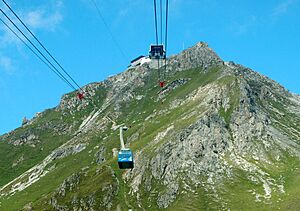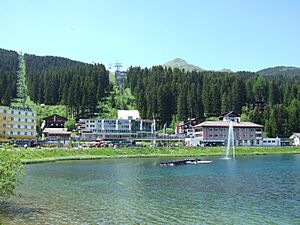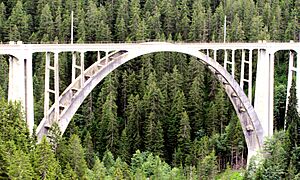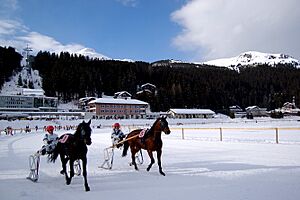Arosa facts for kids
Quick facts for kids
Arosa
|
||
|---|---|---|

Arosa in June 2009
|
||
|
||
| Country | Switzerland | |
| Canton | Graubünden | |
| District | Plessur | |
| Area | ||
| • Total | 154.79 km2 (59.76 sq mi) | |
| Elevation
(Bahnhof Arosa)
|
1,775 m (5,823 ft) | |
| Highest elevation
(Aroser Rothorn)
|
2,980 m (9,780 ft) | |
| Lowest elevation
(Plessur (river) near Calfreisen)
|
710 m (2,330 ft) | |
| Population
(Dec 2020 )
|
||
| • Total | 3,162 | |
| • Density | 20.428/km2 (52.907/sq mi) | |
| Demonym(s) | German: Aroser(in) | |
| Postal code |
7050 Arosa, 7027 Calfreisen, 7027 Castiel, 7027 Lüen, 7028 Pagig, 7028 St. Peter, 7029 Peist, 7056 Molinis, 7057 Langwies, 7058 Litzirüti
|
|
| Localities | Innerarosa, Maran, Prätschli, Tschuggen | |
| Surrounded by | Alvaneu, Davos, Langwies, Lantsch/Lenz, Molinis, Peist, Schmitten, Tschiertschen, Vaz/Obervaz, Wiesen | |
| Twin towns | Fukumitsu (Japan) | |
Arosa is a lovely town and municipality in Switzerland. It is located in the Plessur Region of the canton of Graubünden. Arosa is a popular place for tourists in both summer and winter.
On January 1, 2013, several smaller towns joined with Arosa. These included Calfreisen, Castiel, Langwies, Lüen, Molinis, Peist, and St. Peter-Pagig.
A big change happened in 2013 for skiers. The Arosa ski area connected with Lenzerheide by a cable car. This created a new, larger ski resort called Arosa Lenzerheide. Now, one pass lets you ski in both areas!
The main language spoken in Arosa is German. However, many people speak a local dialect called Alemannic Swiss German.
Arosa is also famous for its ice hockey team, the EHC Arosa. They used to be one of the best teams in the country.
Contents
Arosa's History
Arosa was first mentioned around the year 1330 as Araus. Later, in 1383, it was called Orossen. The name Arosa first appeared in records in 1428.
Early Settlements and Language Change
People first settled here in the 1200s. Around 1300, German-speaking settlers called Walser arrived from Davos. They replaced the original people who spoke Romansh. For many centuries, the village relied on farming and raising animals in the mountains.
Becoming a Health and Winter Resort
Arosa became a health resort in 1883. A German doctor helped make it a place for people to get well. The first special hospital, called a sanatorium, opened in 1888.
After 1900, Arosa slowly grew into a popular winter resort. The first ski lifts were built in 1938. In 1956, the Weisshorn cable car opened, making it easier to reach the slopes. More lifts followed over the years.
Arosa and Famous People
Did you know that Sir Arthur Conan Doyle, who wrote the Sherlock Holmes books, helped make skiing popular in Switzerland? He was staying in Davos and ordered some skiing "boards" from Norway. He then skied down into Arosa with two guides. He wrote about this adventure in a magazine in 1894. This story encouraged many British skiers to visit Switzerland.
A famous scientist, Erwin Schrödinger, made an important discovery in physics while on vacation in Arosa in 1925. He developed the idea of "wave mechanics" here.
The writer Thomas Mann also stayed in Arosa in 1933 when he first went into exile from Germany.
Arosa's Geography
Arosa covers an area of about 154.79 square kilometers (59.76 square miles). Much of this land is used for farming (42%) or is covered by forests (15.2%). About 3.1% of the land has buildings and roads. The rest (39.7%) is made up of rivers, glaciers, and mountains. These natural features are what attract many tourists to Arosa.
The town of Arosa sits high up in the Schanfigg valley. It is at the base of the Aroser Weisshorn, a mountain that is 2,653 meters (8,704 feet) tall. The different parts of Arosa, like Innerarosa and Maran-Prätschli, are located at elevations between 1,690 and 1,950 meters (5,545 and 6,398 feet).
There are two lakes right in the middle of Arosa. These are the Obersee (upper lake) and the Untersee (lower lake). The town's train station is at the end of a special branch line that comes from Chur.
Tourism in Arosa
Arosa is well-known for its safe and fun skiing area. It has over 60 kilometers (37 miles) of ski slopes for all skill levels.
Tourism is the main business in Arosa. There are more than 4,200 beds available for guests. Most people in Arosa work in the tourism industry. This includes jobs in hotels, restaurants, and ski resorts.
Arosa's Population
Arosa has a year-round population of about 3,205 people. This number can change a lot depending on the season. For example, in January, there might be around 4,600 people, but in May, it could drop to about 2,500.
In 2000, most people in Arosa (79.8%) spoke German. Portuguese was the second most common language (7.3%), followed by Italian (4.1%).
The population of Arosa has changed over time:
| year | population |
|---|---|
| 1550–1750 | c. 125 |
| 1850 | 52 |
| 1900 | 1,071 |
| 1930 | 3,466 |
| 1941 | 1,980 |
| 2000 | 2,771 |
Important Heritage Sites
Arosa has some important historical places. The Carschlingg site near Castiel is an ancient settlement from prehistoric times. It was also used during the late Roman Empire and early Middle Ages.
Another important site is the Langwieser Viaduct. This is a large bridge for the Rhätische Bahn (Rhaetian Railway). Both of these are listed as important Swiss heritage sites. The small villages of Medergen, Sapün, and Strassberg are also recognized for their historical value.
Arosa's Climate
Arosa has a climate with short, cool summers and long, cold winters. It gets a lot of rain and snow throughout the year. On average, Arosa receives about 723 centimeters (285 inches) of snow each year.
Between 1961 and 1990, Arosa had about 147 rainy days per year. The wettest month was August, with an average of 159 millimeters (6.3 inches) of rain. February was the driest month, with about 75 millimeters (3 inches) of rain.
| Climate data for Arosa (1991–2020) | |||||||||||||
|---|---|---|---|---|---|---|---|---|---|---|---|---|---|
| Month | Jan | Feb | Mar | Apr | May | Jun | Jul | Aug | Sep | Oct | Nov | Dec | Year |
| Mean daily maximum °C (°F) | −0.5 (31.1) |
−0.4 (31.3) |
2.1 (35.8) |
5.1 (41.2) |
9.7 (49.5) |
13.7 (56.7) |
15.7 (60.3) |
15.7 (60.3) |
11.7 (53.1) |
8.6 (47.5) |
3.4 (38.1) |
0.2 (32.4) |
7.1 (44.8) |
| Daily mean °C (°F) | −3.4 (25.9) |
−3.8 (25.2) |
−1.4 (29.5) |
1.8 (35.2) |
6.1 (43.0) |
9.9 (49.8) |
11.8 (53.2) |
11.9 (53.4) |
8.3 (46.9) |
5.3 (41.5) |
0.5 (32.9) |
−2.5 (27.5) |
3.7 (38.7) |
| Mean daily minimum °C (°F) | −6.7 (19.9) |
−7.5 (18.5) |
−5.0 (23.0) |
−1.6 (29.1) |
2.5 (36.5) |
5.8 (42.4) |
7.8 (46.0) |
8.2 (46.8) |
4.6 (40.3) |
1.6 (34.9) |
−2.8 (27.0) |
−5.7 (21.7) |
0.1 (32.2) |
| Average precipitation mm (inches) | 77 (3.0) |
65 (2.6) |
73 (2.9) |
77 (3.0) |
97 (3.8) |
132 (5.2) |
136 (5.4) |
158 (6.2) |
104 (4.1) |
90 (3.5) |
90 (3.5) |
80 (3.1) |
1,179 (46.4) |
| Average snowfall cm (inches) | 116 (46) |
105 (41) |
100 (39) |
78 (31) |
25 (9.8) |
6 (2.4) |
2 (0.8) |
2 (0.8) |
12 (4.7) |
42 (17) |
91 (36) |
114 (45) |
693 (273) |
| Average precipitation days (≥ 1.0 mm) | 10.6 | 9.5 | 11.2 | 10.9 | 13.0 | 14.2 | 14.0 | 13.9 | 10.7 | 9.4 | 10.6 | 11.0 | 139.0 |
| Average snowy days (≥ 1.0 cm) | 12.8 | 11.9 | 12.2 | 9.5 | 4.3 | 1.0 | 0.4 | 0.4 | 2.0 | 4.6 | 10.9 | 13.2 | 83.2 |
| Average relative humidity (%) | 64 | 66 | 68 | 69 | 71 | 72 | 72 | 73 | 73 | 67 | 68 | 66 | 69 |
| Mean monthly sunshine hours | 110 | 113 | 141 | 148 | 155 | 170 | 197 | 184 | 152 | 136 | 96 | 90 | 1,693 |
| Percent possible sunshine | 53 | 50 | 47 | 43 | 39 | 42 | 48 | 50 | 49 | 52 | 45 | 46 | 47 |
| Source: MeteoSwiss | |||||||||||||
Transportation in Arosa
The Rhaetian Railway runs frequent train services. These trains connect Arosa to Chur on the Chur–Arosa railway line.
Notable People from Arosa
Many interesting people have connections to Arosa:
- Carl Rüedi (1848 – 1901 in Arosa) was a Swiss lung doctor. He treated the famous author Robert Louis Stevenson.
- Alfred Michael Koch (born 1894 in Arosa – 1984) was a Canadian flying ace. He was born in Arosa and was known for his ten aerial victories.
- Paul ten Bruggencate (1901 in Arosa – 1961) was a German astronomer. He studied stars and space.
- Youri Messen-Jaschin (born 1941 in Arosa) is an artist. He is known for combining different painting styles.
Sports Stars from Arosa
Arosa has also produced several talented athletes:
- David Zogg (1902–1977) was a Swiss skier. He was good at both alpine skiing and Nordic combined events.
- Werner Lohrer (1917 in Arosa – 1991) was an ice hockey player. He won a bronze medal at the 1948 Winter Olympics.
- Heini Lohrer (1918 in Arosa – 2011) was also an ice hockey player. He won a bronze medal at the 1948 Winter Olympics with his brother Werner.
- Roger Staub (1936 in Arosa – 1974) was an alpine ski racer. He won a gold medal at the 1960 Winter Olympics.
- Werner Geeser (1948 in Arosa – 2011) was a Swiss cross-country skier. He competed in the 1972 Winter Olympics.
- Engelhard Pargätzi (born 1959 in Arosa) is a retired Swiss alpine skier. He competed in the 1976 Winter Olympics.
- Isabel Waidacher (born 1994 in Arosa) is a Swiss ice hockey player. She has won the Swiss championship six times with her team.
See also
 In Spanish: Arosa (Grisones) para niños
In Spanish: Arosa (Grisones) para niños









